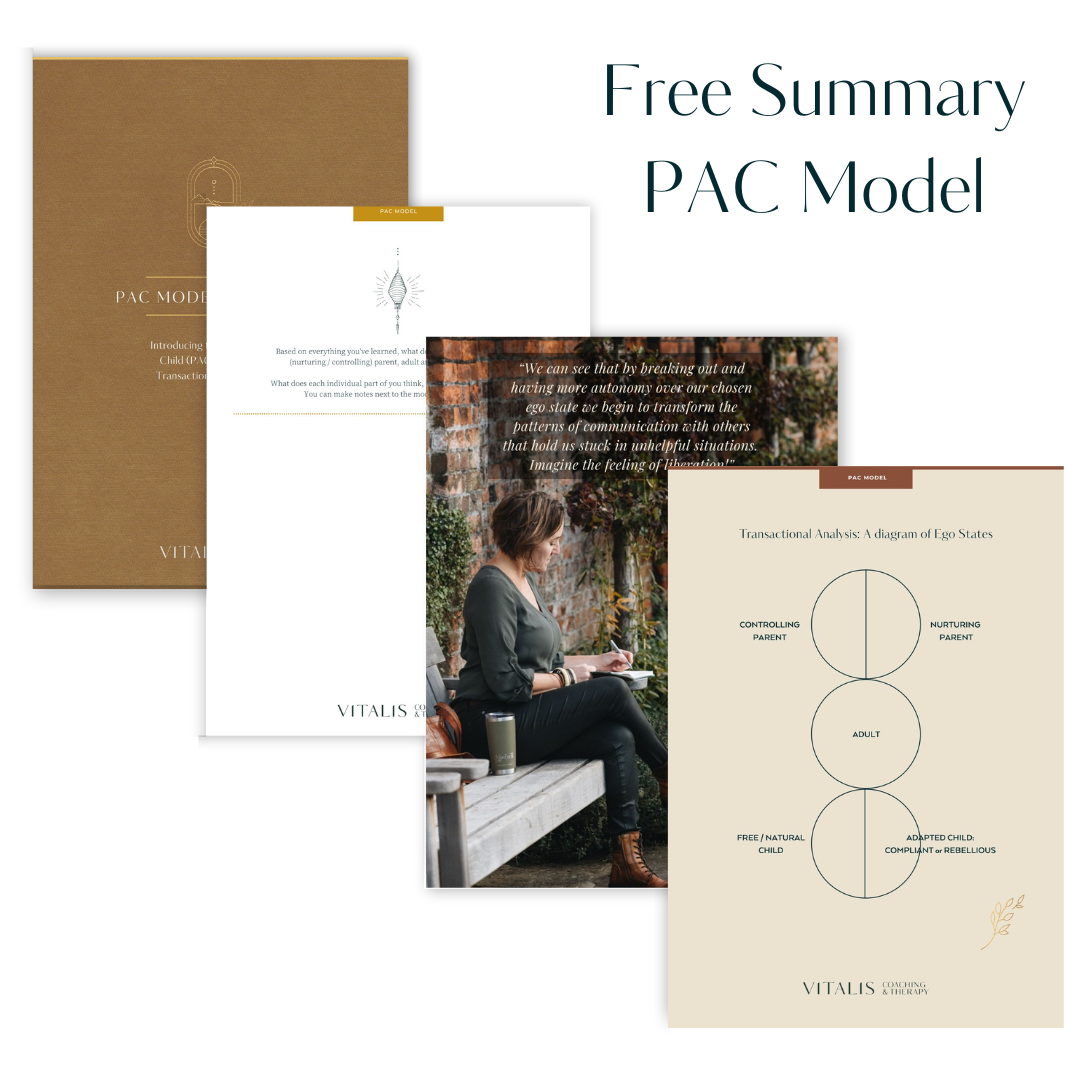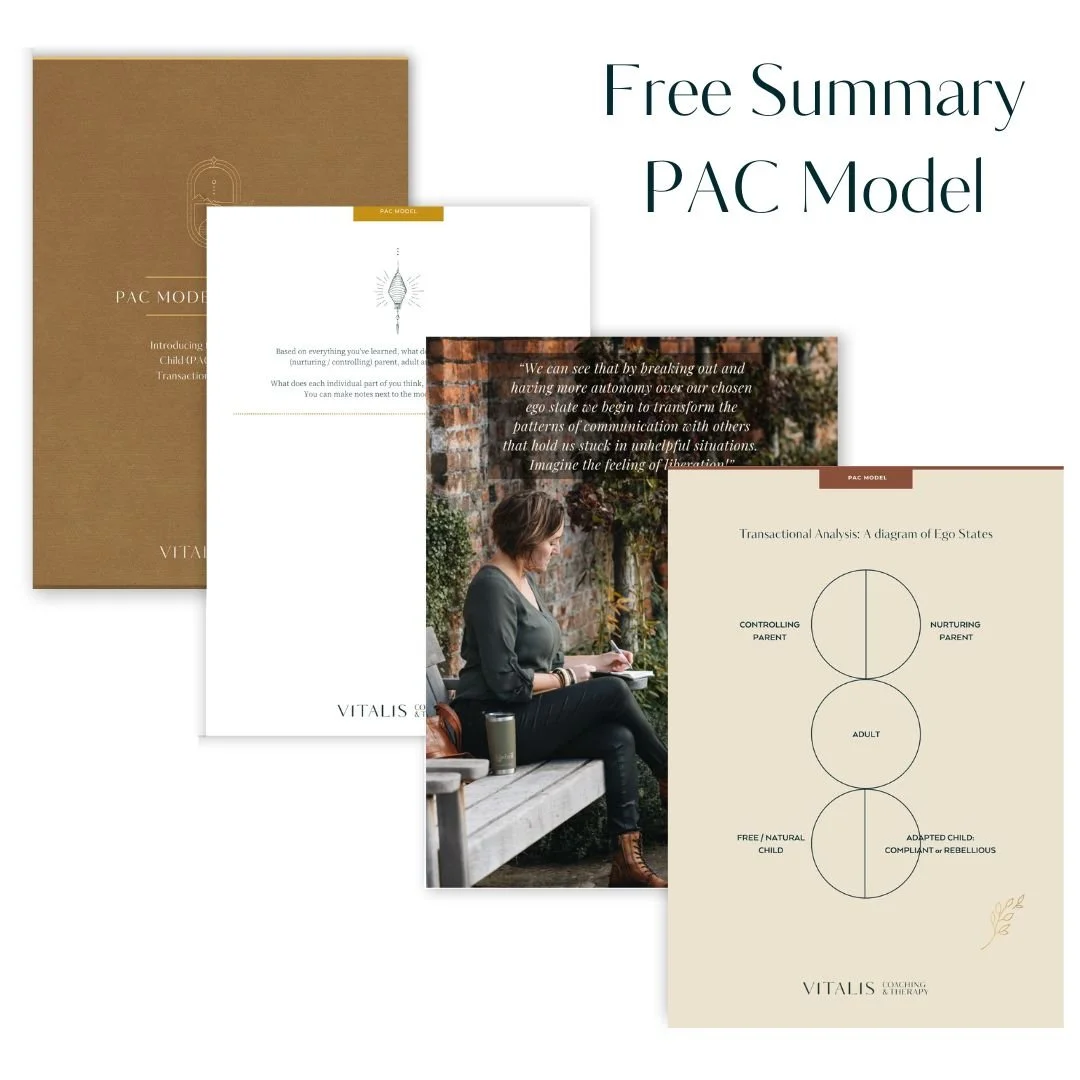What is the Parent Adult Child Model (PAC) model in Transactional Analysis?
A transformational approach to improve our relationships, enhance our communication and free ourselves from unhelpful patterns.
How often have you had an interaction with someone where you find yourself triggered into unhelpful critical reactions rather than thoughtful kind responses, where you feel like you’re completely misunderstanding each other, or where you find you almost revert to the childish version of yourself and end up feeling disempowered, hurt and frustrated?
We all, at some time or another, find ourselves in situations where we would like more choice over our behaviour, where we recognise that we are stuck in a negative pattern and yet there is a sense that there must be a better way. The Parent Adult Child Model (PAC), a core concept of TA, is here to help.
Summary: What is the Parent Adult Child Model (PAC) model in Transactional Analysis (TA)?
The Parent Adult Child model is a way of understanding how we think, feel, and behave in relationships by noticing which “ego state” we are speaking or reacting from in any given moment.
Parent Ego State: The internalised voice of our parental figures or primary caregivers — either caring and supportive (Nurturing Parent) or critical and controlling (Controlling Parent).
Adult Ego State: Our grounded, present-day self — able to respond to the here-and-now with clarity, reason, and emotional awareness, rather than reacting from old wounds.
Child Ego State: The younger parts of us — either free, joyful, and spontaneous (Free Child) or shaped by early coping strategies such as people-pleasing or rebelling (Adapted/Wounded Child).
Practical purpose and application of the model: by recognising which ego state is “driving the bus” in our communication, we gain more choice, improve our relationships, and gently loosen unhelpful patterns that keep us stuck.
Summary of the Parent Adult Child (PAC) Model of Transactional Analysis (TA) by Eric Berne, showing four pages of a free downloadabe pdf.
Grab your free, simple, and effective guide now: download summary of PAC Model including a personalised exercise.
It’s our gift to you, so you can relax knowing you’ve got this useful and powerful pdf with an overview to the Parent-Adult-Child Model ready when you need it. We’ve added an exercise to apply the model to your personal experience for immediate insights to improve the communication with your loved ones.
Register with your email address and download straight away (it's free):
What is the Parent Adult Child Model (PAC) model in Transactional Analysis?
It might be that you find yourself in a string of relationships that end for the same reasons, maybe you have a habit of overreacting or picking fights, maybe you find your partner smothering and find it hard to maintain an equitable position where your self-esteem isn’t diminished over time. Perhaps in your relationships at times you find yourself parenting your partner or your adult children, rather than coexisting on a mutually level playing field, and you feel stuck in cycles of low-grade or significant conflict. And these dynamics can happen at work too. Maybe a leader in your organisation just has this knack of making you feel small or inferior and you find yourself sabotaging your efforts at work by responding in ways that undermine the professional impression you’d like to make.
There are many therapeutic approaches and theories that can help us unpick these various scenarios for greater empowerment, and ultimately choice, as competent adults in the world. Transactional Analysis Theory (TA) for some, can be one of the most powerful. Let’s dive into it’s meaning.
In this blog post I hope to go some way to demystify the Parent-Adult-Child Model of Transactional Analysis, give you another lens in the toolkit for understanding yourself and increase your curiosity for further exploration. It is a hugely nuanced and potentially complex model and has been greatly simplified here, but if you’re keen to explore the detail then “TA today” by Ian Stewart and Vann Joines would be one of my recommended books for your reading list.
Before we delve into the possibilities that exist for us within this model, let’s get to grips with the terminology.
Prefer applying the PAC model with one-to-one support in counselling or therapy?
Transactional Analysis by Eric Berne
What is Transactional Analysis Theory (TA)?
Transactional Analysis (TA) is both a theory and a therapy. Pioneered by Eric Berne in the late 1950’s it has been developed by others since and has various therapeutic applications today.
Transactional Analysis is a theory of communication, of personality, of child development and of psychopathology. It offers us a way of understanding ourselves, our childhood, our behaviour and is a valuable tool to improve communication, relationships and personal and professional performance.
“The moment the little boy is concerned with which is a jay and which is a sparrow, he can no longer see the birds or hear them sing.”
- Eric Berne -
the terminology of TA: ego states
Understanding the meaning of Parent - Adult - Child Model (PAC Model)
Transactional Analysis offers us a way of understanding ourselves and our behaviour through the lens of three aspects of personality, which Eric Berne defined as Ego-States. Each of these psychological mindsets encompasses both an experience and certain feelings, and drives our behaviour as a result.
If we are in the Adult ego state we are thinking, feeling and behaving in response to the here and now using all of our grown-up resources.
If we are in the Parent ego state we are behaving, thinking and feeling in ways which are essentially a copy of our parental figures or main care-givers.
If we are operating from the Child ego state we return to ways of thinking, feeling and behaving that we used as a child. These might have helped us back then to deal with the challenges we were facing, but could end up working against us as a grown-up.
These three states of Parent, Adult, Child are what gives TA its other commonly referenced term of the PAC model.
The theory, in its simplest form, follows that in communication with others we are doing so from any of those three ego states and the other person is also responding from one of those three states. Each exchange of communication is known as a transaction… and communication is built up from a series of transactions. Hence the name transactional analysis, with me so far? 😊
Download this simple yet powerful PDF — free today
We made a summary of the Parent-Adult-Child Model for you. Register with your email address (it's free). Get this simple and time-saving guide to the PAC Model straight away.
Now, let’s go into the subtleties of the meaning of the Parent-Adult-Child Model…
Transactional Analysis: A diagram of Ego States
Parent Ego states - the subtleties
If we dissect the parent ego state, it is suggested by TA that there are two distinctions here. The Controlling (or punitive) Parent (CP) or the Nurturing Parent (NP). These probably require less explanation as I’m sure we can all make a few assumptions and relate.
Fundamentally the Controlling Parent ego state is one that aims to control through criticism and negative judgement, punishes and criticises. The Controlling Parent ego state can feel like a tape which has been saved in our brains, playing on repeat over and over again, telling us everything we are doing wrong.
The nurturing ego state is one that does just that, nurture. It aims to look after, praises, encourages, comforts, cares, teaches and supports. The Nurturing Parent we might assume is always positive, but only, TA asserts, when the Nurturing Parent is provided from a position of genuine positive regard for the person rather than one that disempowers. For example the offer of help with a task, rather than completely taking over.
Adult Ego state - the subtleties
The Adult ego state is about a valid, rational response to what is happening in the factual here and now, without being unhealthily influenced by the unhealed emotions of our past experiences. Instead of projecting our own fears and assumptions onto others, the Adult has a capacity to ask clarifying questions and to not get defensive. There is an awareness of our own inner wounded child and unhealthy critical parent, and an ability to witness these reactions internally, without the need to react outwardly. This conscious awareness can stop our negative inner dialogue, and redirect the communication when others are acting from their Controlling Parent or Adapted Child. There is a useful work related example below.
Embrace Your Inner Child
Let your natural, free inner child come out and play
Child Ego States - The subtleties
Within the child ego state there are nuances that develop depending on the repeated patterns we experienced during our childhood. For example if I was repeatedly rewarded for certain types of behaviour and penalised for other behaviour I would over time adapt my behaviour to yield the most comfortable environment for myself as a child. Occasionally I would be overly compliant (people pleasing behaviours) and sometimes I would be outwardly rebellious (engaged in opposition or resistance), and both of these are adaptations to my natural way of being. Some of those adaptations may be helpful carried into adulthood in certain contexts. Being reminded of good manners at the dinner table for example embeds a social construct to say ‘please’ and ‘thank you’, and saves us having to think about it each time. We just operate from ‘helpful’ conditioning. Other adaptations may not be so helpful or be actively detrimental. Sulking or throwing a tantrum when we don’t get our own way, for example, may yield some results for a child, but are less likely to be successful into adulthood. It might be that a part of us is sort of ‘stuck’ in the past, and reacting from that old place. When we replay those childhood adaptations in our adult life we are said to be operating from the Adapted Child (AC) ego state. The Adapted Child is also referred to as the Wounded Child.
A sub-division within the Adapted Child ego state is made between the Compliant Child (CC) and Rebellious Child (RC):
The Compliant Child is obedient and submissive, searching for external validation and anxious to avoid conflict and (perceived) rejection.
The Rebellious Child prefers to do the opposite of the rules, finds it hard to accept responsibility and authority, tends toward excessive behaviours, and openly express their dissatisfaction. Acts of rebellion can be subtle, for example by forgetting or procrastinating on something that someone asked them to do.
A child makes two decisions – a despairing or a defiant one. The despairing decision is made when the child accepts the parental message - that there is something wrong with him or her. The defiant decision is made when the child tries to fight against the parental message (this message is called an injunction in Transactional Analysis). The child develops coping behaviours to resist the message and master the circumstances. These coping behaviours tend to be extremes that are impossible to achieve and so are doomed to failure (Source: Mc Neel). But it’s important to note that both of these Adapted Child versions are valid reactions to childhood experiences. Growing up with overbearing, aggressive, unreliable or unpredictable care-givers makes a child adapt their natural ways in whichever manner makes them feel safest in their childhood home. These coping mechanisms often don’t serve us anymore as adults, and need an ‘update’ so to speak.
The other nuance of the child ego state is known as the Free or Natural Child (FC). Sometimes called the Divine Child. This is when as a child we were experiencing life outside of parental influence, acting under our own steam, neither moulding our behaviour to please others or actively rebelling. Our natural, free child feels utterly worthy of love, confident, open, spontaneous and free. It’s a wonderful source of creativity and playfulness. My clients often describe this part of themselves as joyous and care-free.
On any given day, hour or minute, we might move through any or all of these ego states in our interactions with others. We will have established patterns that exist with those people closest to us or with who we interact regularly. We may also be operating from a mixture of these states and get stuck in one or the other, which we’ll get on to, but for now let’s try to keep things simple. Thank you for reading this far, let’s keep going with a great example!
PAC Model in action in your relationships and communication
Let’s give you a day-to-day example of Transactional Analysis
To get more of a feel for each of these ego states let’s take the very simple example of asking someone the question “what time is it?”. Depending on which ego state they are identifying with at the moment of their reply, will determine their thinking and therefore their reaction, and it might go something like this:
Controlling/Punitive Parent response:
“Gosh, don't you have your own watch to look at? Don't you have eyes in your head to have a look at the clock yourself? And by the way, whenever I go anywhere with you we are always late, so I seriously don't know why you bother asking me what time it is.”
Nurturing Parent response:
“Just do your best to get ready as soon as possible. I really look forward to spending time with you, and so are the people we are meeting. So let's try to arrive on time, but don't get yourself stressed. Let’s have a nice day together.”
Adapted/Wounded Child response:
Rebellious: “Why would I care what time it is? I am doing my own thing anyway, and won't join your plans!”
Compliant: “What is the right answer? What would you like me to say? If I say this-and-this time, would we then still be friends?”
Natural / Free Child: “It's time to love you! To smell the roses, to enjoy life fully, to watch the butterflies, and to go on adventures! This is an excellent moment to be happy, and I'm just going to give you a massive hug.”
Adult Response:
“It is five minutes past ten.” (Or whatever the actual time is at that moment).
With this very simple example we can see a whole range of possible directions for our communication, some potentially more helpful than others in any given situation…
Each of these ego states is made up not only of the words expressed, but by the tones, gestures, posture and facial expression characteristics of each. All of that information forms a whole picture that enables us to more clearly identify which of those ego states might be driving the bus, so to speak. And you want to make sure your healthy ego states are behind the steering wheel of your life!
Would you like to try it yourself right now?
Transactional Analysis Therapy: A transformative exercise
If you’d like to explore this a little more deeply for yourself you might like to model out the phrases, body language, facial expressions and tones that are typical for you in each of those states. Think of an example when you might have dropped into an overbearing or controlling parent mode for example, how do you know? What was your body doing? What gestures are apparent? Any finger wagging, eye glaring, harsh tone you can identify? What phrases remind you of your parents when they were being particularly critical? I know for myself I can almost hear the voice of one of my parents coming out of my own mouth at times… Do the same for your free, rebellious and compliant child states.
Getting an understanding of our own subtle representations of these ego states can help us be more aware in the moment when we slip into them, and awareness is the first step to more agency.
Free coaching exercise: Find the Right Direction in Life
Find out what you really want and identify what matters to you most - dowload today:
THE PAC MODEL AT WORK
Let’s play this out with a tangible work related example
Jayesh is in the office and one of his subordinates comes in late and he chastises him from his Critical Parent ego state:
(CP) “For heaven’s sake Paul this is the third time this week you’ve been late, you really need to pull your socks up, what’s your excuse?”
If Paul responds from his Adapted Child it sounds something like
(AC) “Oh gosh Jayesh, I’m so sorry please don’t fire me, I’ll do better!”
This may go on for example with Jayesh staying in his Controlling Parent and coming back with
(CP) “Good. Make sure you do, don’t let it happen again or there’ll be trouble…”
Yet if in that same scenario Paul is able to avoid an Adapted Child reaction, we can see how Jayesh is forced to shift out of his Controlling Parent state in order for the communication to continue:
(CP) “For heaven’s sake Paul, this is the third time this week you’ve been late, you really need to pull your socks up, what’s your excuse?”
Paul responding from Adult instead of the expected Adapted Child might reply:
(A) “You’re understandably frustrated Jayesh and I apologise, I should have made you aware that I’ve had to take my son to hospital for his treatment this week as his mum is sick, and I didn’t allow for traffic. I’ll leave more time tomorrow to make sure I’m here on time.”
It would be inappropriate for Jayesh to continue from his Controlling Parent and so there is a tension created that invites him to shift into a more adult (or perhaps nurturing parent) ego state in response.
we can begin to see that by breaking out and having more autonomy over our chosen ego state we can begin to transform the patterns of communication with others that hold us stuck in unhelpful situations. Imagine the feeling of liberation!
Use PAC model to improve your communication
Quite exciting isn’t it? Ready to start practising?
The ideal aim for grown-up humans is that we have choice over our ability to remain, as far as possible and appropriate, in the right ego state for the situation, the position that gives us most freedom, flexibility and empowerment in any given moment.
That will usually be a combination of the Adult Ego State, Nurturing Parent and Free Child. The Adult ego state allows us to make rational decisions based on accurate and appropriate reading of a situation, rather than inflated on distorted interpretations that might come from early childhood experiences. The Nurturing Parent ego state brings kindness, patience and encouragement. And our Free Child brings our life-force back into flow, full of positive self-belief, joy and spontaneity!
Like to learn more about Transactional Analysis? There’s a second post in which we explore your Script of Life / Life Script, essentially the narrative of your life written for yourself roughly before the age of seven, which we play out as adults with gusto but without the results we are hoping for:
The meaning of the Parent Adult Child model in daily life
So, how can we actually use this understanding of TA to support our own personal, professional and spiritual development?
TA gives us a great tool for developing self-awareness and a framework to understand and begin to shift our own behaviours.
Taking some time to become familiar with each of the ego states and how they look and feel for you can start to bring the unconscious into view. Noticing when you or people around you slip into the different ego states can be hugely helpful in identifying blind spots. Reality TV is a great practice ground for this. As you watch people, can you identify which ego state they are in? What are the clues in their behaviour?
At what point in your interactions do you find yourself reverting to child or slipping into dominating parent for example? Are certain people more likely to evoke it in you than others? What ego state are they in when this happens? Which state would be more helpful for you in those moments?
So much to explore, so much potential to grow. May you enjoy playing around with this PAC Model, and may it benefit the relationships in your life.

























